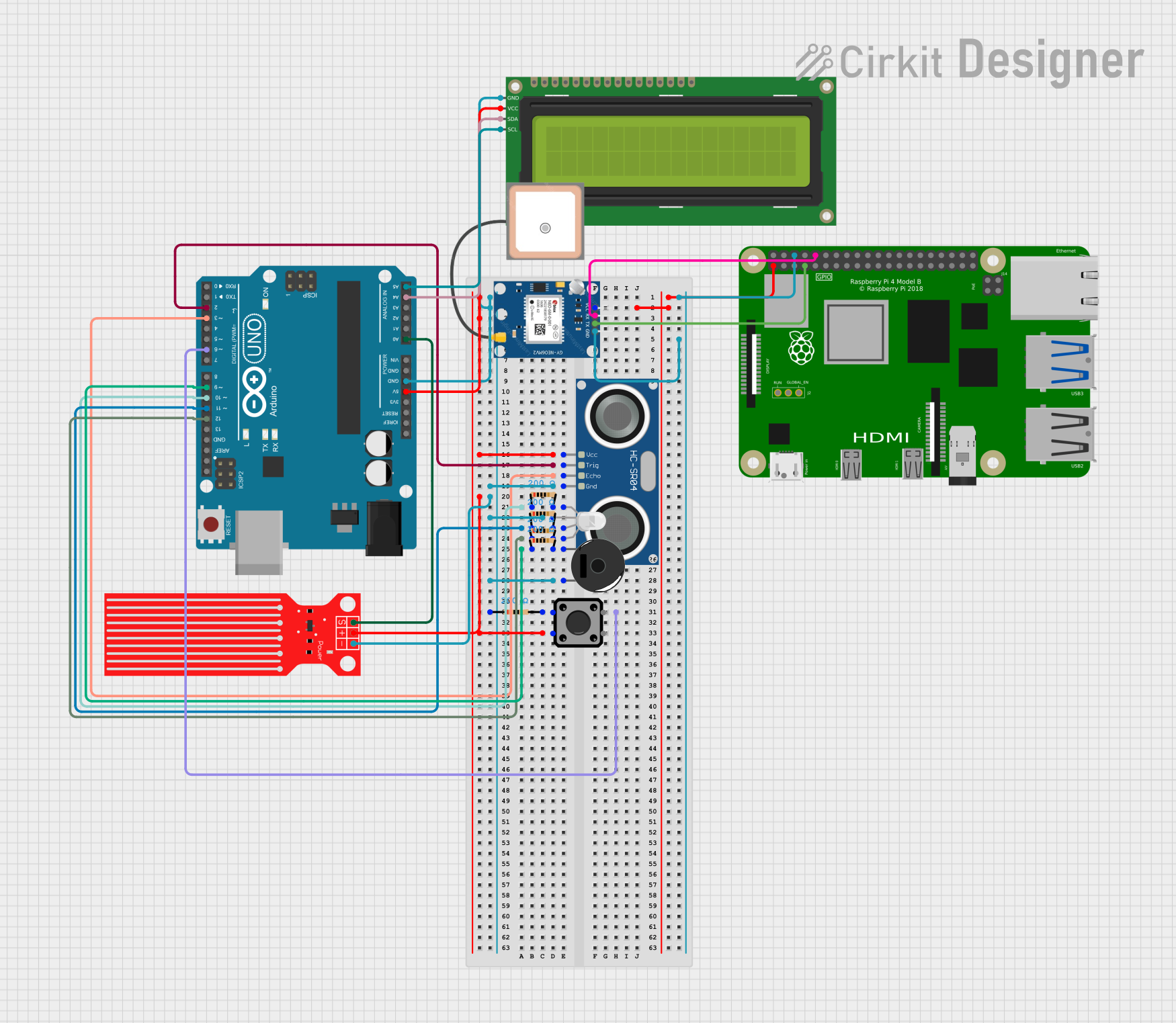
Arduino and Raspberry Pi Sensor System with GPS and Ultrasonic Capabilities

Circuit Documentation
Summary
This circuit integrates a variety of components including an Arduino UNO, an HC-SR04 Ultrasonic Sensor, a 16x2 I2C LCD, a Raspberry Pi 4B, a Piezo Buzzer, a Water Level Sensor, an RGB LED, a GPS NEO 6M module, several resistors, and a tactile switch button. The Arduino UNO serves as the primary microcontroller, interfacing with sensors, an LCD display, and an RGB LED. The Raspberry Pi 4B is used for more complex processing and communication with the GPS module. The circuit is designed to measure distances using the ultrasonic sensor, detect water levels, provide visual feedback through the LCD and RGB LED, and emit sounds with the buzzer. The GPS module allows for location tracking.
Component List
- Arduino UNO: A microcontroller board based on the ATmega328P, featuring digital and analog I/O pins.
- HC-SR04 Ultrasonic Sensor: A sensor for measuring distance through ultrasonic sound waves.
- 16x2 I2C LCD: A liquid crystal display that can show 16 characters per 2 lines, with an I2C interface for communication.
- Raspberry Pi 4B: A small computer with GPIO pins capable of complex processing and peripheral interfacing.
- Piezo Buzzer: An electronic device that emits sound when an electric signal is applied.
- Water Level Sensor: A sensor used to detect the level of water in a container or environment.
- RGB LED (Wokwi compatible): A light-emitting diode that can display multiple colors by mixing red, green, and blue light.
- GPS NEO 6M: A module for receiving GPS signals and determining geographical location.
- Resistor: A passive two-terminal electrical component that implements electrical resistance as a circuit element.
- Tactile Switch Buttons - 12mm Square: A simple switch mechanism for control of a physical process or a machine.
Wiring Details
Arduino UNO
- 5V: Connected to VCC of HC-SR04 Ultrasonic Sensor, 16x2 I2C LCD, Water Level Sensor, and Tactile Switch Button.
- GND: Common ground with HC-SR04 Ultrasonic Sensor, 16x2 I2C LCD, Water Level Sensor, Piezo Buzzer, RGB LED, and Tactile Switch Button.
- D2: Connected to TRIG of HC-SR04 Ultrasonic Sensor.
- D3: Connected to ECHO of HC-SR04 Ultrasonic Sensor.
- D9: Connected to Piezo Buzzer through a 200 Ohm resistor.
- D10: Connected to the red pin of RGB LED through a 200 Ohm resistor.
- D11: Connected to the green pin of RGB LED through a 200 Ohm resistor.
- D12: Connected to the blue pin of RGB LED through a 200 Ohm resistor.
- A0: Connected to SIG of Water Level Sensor.
- A4 (SDA): Connected to SDA of 16x2 I2C LCD.
- A5 (SCL): Connected to SCL of 16x2 I2C LCD.
HC-SR04 Ultrasonic Sensor
- VCC: Connected to 5V of Arduino UNO.
- TRIG: Connected to D2 of Arduino UNO.
- ECHO: Connected to D3 of Arduino UNO.
- GND: Common ground with Arduino UNO.
16x2 I2C LCD
- VCC: Connected to 5V of Arduino UNO.
- GND: Common ground with Arduino UNO.
- SDA: Connected to A4 (SDA) of Arduino UNO.
- SCL: Connected to A5 (SCL) of Arduino UNO.
Raspberry Pi 4B
- 3V3: Connected to VCC of GPS NEO 6M.
- GND: Common ground with GPS NEO 6M.
- GPIO4: Connected to TX of GPS NEO 6M.
- GPIO15: Connected to RX of GPS NEO 6M.
Piezo Buzzer
- Pin 1: Connected to D9 of Arduino UNO through a 200 Ohm resistor.
- Pin 2: Common ground with Arduino UNO.
Water Level Sensor
- SIG: Connected to A0 of Arduino UNO.
- VCC: Connected to 5V of Arduino UNO.
- GND: Common ground with Arduino UNO.
RGB LED (Wokwi compatible)
- R: Connected to D10 of Arduino UNO through a 200 Ohm resistor.
- G: Connected to D11 of Arduino UNO through a 200 Ohm resistor.
- B: Connected to D12 of Arduino UNO through a 200 Ohm resistor.
- COM: Common ground with Arduino UNO.
GPS NEO 6M
- VCC: Connected to 3V3 of Raspberry Pi 4B.
- RX: Connected to GPIO15 of Raspberry Pi 4B.
- TX: Connected to GPIO4 of Raspberry Pi 4B.
- GND: Common ground with Raspberry Pi 4B.
Resistor
- Four 200 Ohm resistors are used in the circuit to limit current to the RGB LED and Piezo Buzzer.
Tactile Switch Button
- Pin 1: Connected to 5V of Arduino UNO.
- Pin 2: Connected to ground through a 200 Ohm resistor.
Documented Code
Arduino UNO Code (sketch.ino)
void setup() {
// put your setup code here, to run once:
}
void loop() {
// put your main code here, to run repeatedly:
}
Note: The actual functionality of the code is not provided in the input, so the code above is a template and needs to be filled in with the specific logic required for the circuit's operation.